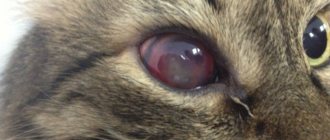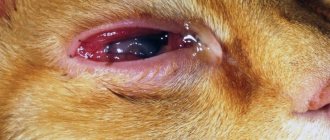The development of veterinary medicine for small animals in our country began relatively recently. Just 30-40 years ago, most people would not even think about investing in pet care. Productive and economically useful animals were treated. And while dogs could still be classified in this group with a stretch, cats did not fall into this category. The lack of demand for the treatment of domestic cats has prevented the development of veterinary medicine in this area. The lack of knowledge among veterinarians and the general population has led to the birth of myths about the impeccable health of cats: “cats practically do not get sick, and if they do get sick, it is incurable.” Unfortunately, the stereotype that has developed in this way still prevents many cat owners from being attentive to the health of their little friends and preventing their diseases. This article will introduce you to the most common diseases of cats.
Signs of all diseases can be divided into specific and nonspecific. Nonspecific signs are manifested by the poor condition of the animal as a whole and are observed to varying degrees in almost all pathologies. These include: increased body temperature (above 39 °C), decreased appetite, apathy, and decreased social activity. Specific signs of diseases directly indicate the area of a possible problem.
Symptoms of cat diseases
If your pet's health deteriorates, this is indicated by a number of visible symptoms that you need to pay attention to:
- the animal refuses to eat or begins to eat excessively;
- hair falls out;
- ulcers form on the skin;
- discharge of various etiologies from the eyes, ears, nose;
- low or high temperature, temperature standard 37.5-39 degrees;
- vomit;
- loose stool;
- the appearance of blood particles in the stool or urine;
- prolonged retention of urine.
Eye diseases in cats
Most often, eye diseases manifest themselves immediately and can be seen because:
- pus is released;
- the cornea becomes cloudy;
- the eye turns red;
- the pupil narrows or dilates;
- swelling appears.
It is necessary to immediately contact a veterinarian, and to prevent the cat from going blind, you should not resort to traditional methods or self-medication.
Conjunctivitis
This is an inflammation of the mucous membrane of the eye. It is divided into:
- purulent;
- catarrhal;
- follicular;
- ulcerative
A very common disease among cats, inflammation can be the cause.
- Foreign body.
- Eye injuries;
- Avitaminosis.
- Infections.
Kittens often experience two diseases at once - rhinitis and conjunctivitis, as the infection rises from the nasopharynx into the lacrimal canals.
Symptoms of the disease:
- red eyelid;
- edema;
- lacrimation.
Blepharitis
This is inflammation of the eyelid, it happens:
- ulcerative;
- scaly;
- simple;
- meibomian.
It manifests itself as redness and swelling; if treatment is not carried out in time, pus begins to be released, eyelashes fall out, and it is also possible that the cat may be left without eyes due to the degeneration of blepharitis into panophthalmitis.
Keratitis
Damage to the cornea of the eye, the shine in the eyes disappears and a white coating forms, caused by injury or infection.
The main symptom of the disease is profuse lacrimation; photophobia also often manifests itself, after which the eye begins to stand out, so the animal tries to stay in a dark room.
If you do not seek help in a timely manner, the second eye may become infected.
Cataract
The disease manifests itself as clouding of the lens and is more common in older animals.
The cat's vision decreases, he begins to move slowly, and often bumps into objects.
Initially, they try to treat with medication; if there is no progress, treatment is carried out surgically.
Panophthalmitis
With this disease, all layers of the eye and the tissue around it are affected. A manifestation of this disease is an increase in the volume of the eyeball and the appearance of copious discharge of pus.
Treatment of such a disease is possible only surgically - the affected organ is removed and the eyelid is sutured.
Turn of the century
The lower eyelid turns toward the eyeball, which injures it, resulting in inflammation and infection of the wound. To help your pet, it is necessary to surgically correct the genetic disease; after the operation, such a disease will not recur.
Eye diseases in cats
Diseases of the genitourinary system of cats and cats
Cats often suffer from this type of illness. It is important to notice and prevent them in time.
Polycystic kidney disease
It is characterized by the multiple appearance of cysts in the kidneys, which are filled with fluid. Most often, polycystic kidney disease appears in animals at 7 years of age. Often, the disease is hereditary.
In the early stages of the appearance of cysts, the pet will feel well, only after they grow there will be obvious symptoms.
Kidney failure
There are two types - acute and chronic. Acute manifests itself sharply, due to infection entering the kidneys, and during chronic kidney cells gradually lose their function, and over time the organ shrinks, and renal failure appears.
First signs:
- your pet urinates more often;
- often constipation, vomiting;
- weight loss;
- sleeps most of the day;
- hair falls out or becomes dull.
Urolithiasis disease
Appears as a result of an infection that spreads throughout the entire genitourinary system. Most often it develops due to sand and stones, which are formed due to the high content of salt deposits.
Manifestations:
- anxiety;
- increased urine volume;
- when urinating, the animal meows;
- blood appears in the urine;
- temperature;
- vomit.
It is imperative that at the first symptoms you need to take the animal to the veterinarian so that medical assistance can be provided in a timely manner.
Cystitis
Cystitis is manifested by inflammation of the bladder.
Signs:
- the cat often gives voice;
- urinates all over the apartment;
- meows when urinating.
The causes of cystitis may be:
- Infectious diseases.
- Diabetes.
- Stress.
- Unbalanced diet.
- Frequent hypothermia.
Pyometra
Inflammation of the uterine mucosa, which is manifested by purulent discharge.
May cause pyometra:
- failure to comply with sanitary conditions;
- cystitis or vaginitis;
- spontaneous abortion;
- infections;
- decreased uterine tone;
- decreased immunity.
Mastopathy
Appears due to the high content of progesterone and prolactin in the pet’s body.
There are two types of mastopathy - physiological and pathological. Most often, the disease occurs due to a malfunction in the body, for example, the endocrine system or liver. It is also more common in unneutered pets or in those who have never bred.
Manifestations:
- hardening of the glands;
- edema;
- soreness;
- redness;
- local temperature increase;
- discharge.
Treatment
Respiratory diseases in cats and cats
Let's look at the most popular ones.
Asthma
Bronchial asthma is manifested by muscle spasms and narrowing of the lumens of the bronchi. Most often, asthma occurs due to an allergic reaction, which can be caused by both dust and food.
The cat begins to thrash and gasp, wheezing or whistling appears, the animal tries to stretch its body upward to make air access possible.
Pulmonary edema
Occurs as a result of improper or untimely treatment; fluid collects in the lungs, which prevents the pet from breathing normally.
Manifestation:
- dyspnea;
- anxiety;
- breathing occurs abdominally;
- mucous membranes become blue due to lack of oxygen;
- the cat takes the same poses for several days;
- coughing;
- wheezing.
Cough
Most often, coughing occurs when the pet is in normal condition, as he is trying to regurgitate a hairball, but if wheezing occurs and the cat begins to meow heavily, you need to consult a veterinarian.
Runny nose
It appears due to inflammation of the nasal mucosa.
Manifestations:
- sneezing;
- breathing occurs through the mouth;
- discharge;
- The cat rubs its nose with its paws.
Rhinitis can also manifest itself due to a foreign body, so in order to prevent the death of your pet, it is necessary to take it to a veterinary clinic as soon as possible.
Calcevirus infection
Most often, kittens get sick; the infection is transmitted through saliva.
Manifests:
- high temperature;
- lethargy;
- the appearance of ulcers on the oral mucosa;
- profuse salivation.
A runny nose and watery eyes may also appear.
Inhalation
Maybe the cat is sick?
There are usually several dangerous symptoms indicating an unhealthy state of a pet. And if you notice something suspicious about your pet, then analyze its condition as a whole.
Signs that a cat is sick:
- The animal became inactive. The pet does not react to toys, food, and even irritants that previously caused a strong reaction in him (for example, a vacuum cleaner). Spends most of his time sleeping.
- The animal, on the contrary, can become very active. For example, if your cat follows you and constantly meows for no reason, he may be trying to show you that something is bothering him.
- Refuses food completely or partially. Loss of appetite is observed in cats during the hot season. This is due to the fact that many breeds have difficulty withstanding heat. But by autumn, appetite is usually restored. If the loss of appetite is not associated with temperature changes, and is also accompanied by apathy of the pet, then most likely he is sick.
- Painful urination. The pet's urine becomes dark in color and when visiting the litter box, the cat may meow in pain. All of the above symptoms may indicate urolithiasis.
- Watery or purulent discharge from the nose or eyes can be a sign of both allergic reactions and infectious diseases.
- Scratching the ears and the area nearby, neck. In this case, it is worth checking your pet for the presence of ear mites, fleas and other ectoparasites.
- Diarrhea, nausea, vomiting. May be a sign of animal poisoning.
- The animal does not step on its paw. This may be a sign of either a dislocation or sprain, or external damage (cut, abrasion).
- Hair loss and the formation of bald patches are often a sign of ringworm. The disease is contagious.
- Bloating in general or enlargement/bulging of a particular area. More often it is a sign of liver disease or other internal organs.
- Presence of blood, pus, and mucus in feces.
- Increased body temperature.
- Loss of body weight.
- Putrid odor from the mouth or ear.
Gastrointestinal diseases in cats
Liver lipidosis often occurs; due to a malfunction in the liver, fat begins to accumulate in the cells, which first provokes a decrease in the functions of the organ, and then leads to a complete loss of its function.
Causes of liver lipidosis:
- infections;
- oncology;
- toxic poisoning.
Most often found in sedentary cats, which are often transmitted.
Symptoms:
- outwardly the cat becomes more mature;
- loses weight;
- vomiting appears;
- lethargy;
- profuse salivation.
Volvulus
Occurs due to refraction of the mesenteries between the stomach and esophagus, as a result of which blood access is blocked, organ tissues die.
Causes:
- tumor;
- active lifestyle;
- injury or blow;
- endocrine system disruption;
- foreign bodies;
- worms.
Symptoms of the disease:
- meow;
- anxiety;
- refusal of food;
- vomit;
- painful stomach;
- constipation;
- weight loss.
Diarrhea
Diarrhea is defined as an animal defecating more than 7 times a day.
Diarrhea is distinguished:
- liquid;
- watery;
- mushy.
Causes.
- Infection.
- Stress.
- Allergy.
- Unbalanced diet.
- Frequent overeating.
- Poisoning.
Cat examination
Stomach ulcer
A stomach ulcer is the appearance of ulcers on the mucous membranes of the stomach and germination into them.
Reasons for appearance:
- unbalanced diet or food from the owners’ table;
- stress;
- medications;
- foreign bodies.
Symptoms.
- Lethargy.
- Vomit.
- Constipation or diarrhea.
- Weight loss.
- Unpleasant odor from the mouth.
Cholangitis
The process by which the bile ducts become inflamed can also inflame the liver and intestines. The cause is believed to be bacterial infection entering the organs.
Symptoms:
- vomit;
- diarrhea;
- yellowness of the mucous membranes and skin;
- fast weight loss.
Gastritis
Gastritis is manifested by inflammation of the stomach. Causes:
- Poor quality food.
- Mixing feed.
- Overfeeding.
- Change of food.
Symptoms.
- Reducing food intake.
- Lethargy.
- Unpleasant odor from the mouth.
- Vomit.
- Weight loss.
- Changes in the brightness and elasticity of the coat.
Pancreatitis
This is an inflammation of the pancreas. The reasons for the appearance may be:
- poor nutrition;
- diabetes;
- cancer;
- toxoplasmosis;
- poisoning;
- medications.
Symptoms of the disease.
- Vomit.
- Painful sensations, the cat screams loudly.
- Abdominal pain when palpated.
- Dehydration.
- Constipation or diarrhea.
- Lethargy.
- Coloration of mucous membranes yellow.
Constipation
This is a condition when a cat cannot recover on its own for a long time.
Causes:
- poor diet, lack of water;
- swallowed a large amount of wool;
- a foreign body interferes with the passage of feces;
- helminths;
- stress.
Symptoms.
- The cat is rushing about.
- Passes small dry feces.
- Screams during bowel movements.
If the cat cannot recover for a long time, seek help from a veterinarian.
Cirrhosis of the liver
Occurs due to the proliferation of parenchymal tissue, so the normal functioning of the liver stops.
Causes:
- hepatitis;
- avitaminosis;
- metabolic disease.
Symptoms
The animal feels good for a long time, since the disease begins gradually, when the pet becomes lethargic, fluid appears in the abdominal cavity, most often this is already a long and protracted disease process.
Diseases of the gastrointestinal tract
The organs of the gastrointestinal tract include not only the digestive tube itself, represented by the esophagus, stomach and intestines, but also the organs involved in the digestion of food (liver, gall bladder, pancreas).
The main diseases for this group of diseases include:
- pathologies of the liver (hepatopathy) and biliary tract: fatty liver, inflammation of the gallbladder and its ducts;
- pathologies of the pancreas: pancreatitis;
- Pathologies of the digestive tube include diseases of inflammatory origin: gastritis, enteritis, colitis, and non-inflammatory origin: tumors, helminthiases, protozoonoses.
Often, during play, cats swallow inedible objects, which can cause serious disturbances in the functioning of the gastrointestinal tract.
Specific symptoms of the above diseases are vomiting, diarrhea or, conversely, constipation, the appearance of blood and/or mucus in the stool, change in the color of feces, and increased salivation.
When the first signs of diseases of the digestive system appear, it is necessary to contact a veterinarian as soon as possible. If this is not possible, it is recommended to limit the animal’s food intake - remove food for 10–15 hours, feed an adsorbent (for example, activated carbon or smectite) and provide access to fresh, clean water.
To prevent diseases of the digestive tract and maintain its health, it is important to adhere to the following rules:
- choose a complete, balanced diet with high digestibility. For example, one of the Purina® PRO PLAN® diets. For animals with a tendency to diseases of the digestive system, it is recommended to use the easily digestible food Purina® PRO PLAN® Delicate, the main source of protein in which is turkey meat;
- avoid spontaneous sudden changes in feed;
- carry out regular scheduled deworming (at least 2 times a year);
- do not give food from your table;
- monitor the cleanliness, freshness and quality of the water your cat drinks;
- remove from the cat's field of vision all small objects that could be swallowed during play.
Heart diseases
Heart disease is the most dangerous, so you should carefully monitor your pet.
Heart attack
This is the death of part of the muscle tissue of the heart. Causes:
- old age;
- poor nutrition;
- thrombosis of the lumen of the vessel.
Symptoms
- Blue mucous membranes.
- Dyspnea.
- Unsteadiness while moving.
- Lethargy.
- Decreased heart rate.
Heart failure
It occurs in cats at different ages; the main cause is a decrease in the performance of the heart muscles.
Symptoms
- Thirst.
- Dyspnea.
- Evening cough.
- Refusal of food.
- Increase in body weight.
- Fainting.
To accurately establish a diagnosis, you need to consult a veterinarian.
Heart diseases
Skin diseases of cats and cats
This type of disease is also quite common among pets.
Ulcers on the body
These are not deep wounds that appear due to improper functioning of the fiber; externally the wound is covered with a crust. The shape of the ulcer is divided into round and oval. If left untreated, the edges of the wound become denser and the crust rises above the skin.
Reasons for appearance:
- injuries;
- infection in wounds or cuts;
- animal bites;
- allergies to medications or food;
- metabolic disease;
- decreased immunity;
- decreased levels of vitamins in the blood;
To prevent ulcers from degenerating into other more serious diseases, it is necessary to immediately begin their treatment after consulting a doctor.
Lichen
Most often, lichen is caused by fungi that enter the pet's skin in different ways.
Signs:
- hair loss in patches;
- skin red;
- the skin is soft to the touch.
Most often located on the head, ears and tail.
The disease is transmitted to humans, so it is necessary to begin treatment at the first appearance of islets
Dandruff
Most often it forms on the tail and back. Normally, a small amount of dandruff may be present in an animal, as layers of skin are constantly peeled off.
Causes:
- dry indoor air;
- infections caused by fungus;
- for ticks;
- metabolic disease;
- obesity.
It is necessary to monitor the humidity in the room, and if dandruff appears profusely, consult a doctor.
Papillomas
These are warts that can form in a cat on any part of the body. If they are not treated in time, they can develop into cancer. The main thing is that if new formations occur, it is necessary to examine the cat and make the correct diagnosis.
Scabs on the head
A very unpleasant disease, the cat behaves restlessly and constantly scratches its wounds.
Reasons for appearance:
- allergic reactions;
- folliculitis;
- ringworm;
- eczema;
- demodicosis
You can try to remove things or products that cause allergies, but it is better to consult a doctor.
Mite
In addition to the fact that the tick sticks to the skin and feeds completely thanks to the cat, it is a parasite that carries many infections. To prevent infection, it is necessary to inspect the pet’s body after walks, and if the cat lives indoors, inspect the skin once a week.
Acne
Inflammation of the sebaceous glands, which most often appears on the chin. Acne resembles nodules that have a white or black dot in the middle. Pets are most often restless, often trying to scratch the place where acne appeared, and as a result of scratching, ulcers appear.
Causes:
- skin diseases;
- defect in the development of sebaceous glands;
- metabolic disease;
- hormonal imbalances;
- liver dysfunction;
For effective treatment it is necessary to choose the right medications.
Dermatitis
The most common flea dermatitis occurs, since during a bite saliva remains, which irritates the skin, the cat begins to itch, and wounds form as a result.
Symptoms:
- dry skin;
- pet restlessness;
- decreased appetite;
- skin wounds;
- itching;
- thin hair in wound areas.
Most often, the disease manifests itself in autumn and spring.
Demodicosis
It is caused by a parasite - a mite, which penetrates the skin, affects the hair follicles and the upper layers of the skin.
Causes:
- poor nutrition;
- decreased immunity;
- infections;
- allergies;
- postoperative period;
- skin injuries.
Symptoms
Redness appears on the skin, then it thickens and over time the size of the redness increases; if the disease is not treated in a timely manner, the cat may develop a local disease.
Notoedrosis
These are scabies mites that affect the deep layer of the skin.
Symptoms.
- Itching.
- Blisters on the skin.
- Hair loss.
If treatment is not started, the disease will spread throughout the skin.
Sarcoptic mange
Caused by the itch mite, it is transmitted to humans.
Symptoms
- Itching.
- Blisters around the neck. nose On the 3rd day they burst and turn into crusts.
- Hair loss.
It is necessary to carefully treat the cat, as the disease spreads quickly.
lice eaters
These are lice that are transmitted from cat to cat or from rodents.
First signs:
- itching;
- peeling of the skin;
- hair loss;
- skin inflammation.
To prevent disease, you need to use insecticides.
Diseases of the skin and coat. Allergic reactions
The skin and fur of cats are a natural barrier that protects the body from the negative effects of environmental factors. In addition to protective, the skin performs thermoregulatory, excretory, and receptor functions. Many metabolic processes take place in the skin, which in one way or another affect the functioning of all body systems. It is not surprising that general ill health and metabolic imbalances often manifest themselves in the form of deterioration in the quality of the skin. The main symptoms of skin and coat pathologies are:
- itching The animal becomes restless and constantly scratches itself;
- changes in the appearance of certain areas of the skin, rashes, formation of redness, weeping spots, swelling, etc.;
- the appearance of a large amount of dandruff and/or sebum;
- excessive shedding;
- complete loss of hair in certain areas (focal baldness).
These signs can be both symptoms of severe systemic diseases (for example, allergies) and true skin problems, for example, flea or tick infestation, fungal skin infections, injuries and burns.
The treatment that a veterinarian can prescribe for a cat will be mainly aimed at eliminating the root cause of the pathology and relieving symptoms.
Prevention of skin diseases includes regular treatment of the animal for parasites, preventing the cat from coming into contact with caustic substances and dangerous objects, and providing balanced feeding.
Diets suitable for cats with problem skin should have the following characteristics:
- sufficient vitamin A and zinc content - promotes better skin regeneration, necessary for collagen synthesis;
- high content of polyunsaturated fatty acids (omega-3 and omega-6) – reduces skin inflammation and improves coat quality;
- high content of antioxidants (vit. E and vitamin C) – enhances the protection of skin cells from the harmful effects of free radicals;
- high protein content to ensure regenerative processes.
The Purina® PRO PLAN® Cat® line of foods are perfectly balanced to provide all body functions, including healthy skin. For animals with problem skin, the Purina® PRO PLAN® Derma Plus® specialized diet is especially suitable. It contains salmon meat as a source of protein, which ensures excellent taste of the food and additionally saturates the diet with polyunsaturated fatty acids. A limited amount of protein sources in the diet reduces its potential allergenicity, which has a beneficial effect on the health of cats with sensitive skin. It has been proven that animals that consume Purina® PRO PLAN® Derma Plus® on an ongoing basis significantly improve the quality of their skin and normalize the molting process.
It is worth noting that manifestations of allergic reactions include not only diseases of the skin and its integument, but also diseases of a variety of organ systems, for example, respiratory, digestive. This means that allergies can also manifest themselves in the form of conjunctivitis, sneezing, coughing, vomiting and diarrhea. A veterinarian will help you identify an allergic disease in a timely manner and prescribe qualified therapy.
Diseases of the nervous system in cats and kittens
Let's look at the most common variations of such ailments.
Epilepsy
These are convulsive seizures that occur as a result of damage to the pet’s nervous system.
Causes:
- head injuries;
- infections;
- toxic poisoning;
- stress;
- inflammation of the brain;
- frequent hypoxia;
- brain cancer.
Symptoms
- Cramps.
- The cat cannot find a comfortable position.
- Hoarse breathing.
- Increased heart rate.
- Foam from the mouth.
- Uncontrollable urination.
- Loss of consciousness.
Seizures can occur several times a day or more often; it is necessary to contact a veterinary clinic to save your pet’s life.
Veterinarian help
Infectious diseases in cats and kittens
Infectious diseases should also be monitored to avoid complications.
Otitis
Manifestations of ear inflammation. It can only be seen when the process has already started, so the owner must pay attention to the cat’s behavior.
Causes of inflammation:
- ear mite;
- allergic reactions;
- viruses of various etiologies;
- wet areas;
- fungi;
- tumors;
- foreign bodies.
Symptoms
- Ear odor.
- Painful sensations when touched.
- Crusts in the ears.
- Purulent discharge.
- Coordination problems.
At the first symptoms, you should consult a doctor so that your cat does not lose his hearing.
Herpes
Caused by a virus, there are three types of rhinotracheitis:
- infectious;
- viral;
- herpesvirus.
To prevent this disease, you can get vaccinated for preventive purposes.
Symptoms
- Decreased appetite.
- Lethargy.
- Vomiting, diarrhea.
- Dyspnea.
- Mouth ulcers.
- Conjunctivitis.
- Temperature increase.
After proper treatment, recovery occurs on the 7th day.
Salmonellosis
This is an infection that affects not only the gastrointestinal tract, but also the respiratory system; also, due to the severe course of the disease, intoxication of the body develops.
Only 2 weeks after entering the body, the disease manifests itself in a pet with the following symptoms:
- lethargy;
- refusal of food;
- increase in general temperature;
- nasal discharge, often purulent;
- vomit;
- excessive salivation;
- cough;
- liquid feces;
- convulsions.
If help is not provided in time, the pet may die on the 3rd day.
Calcivirosis
The disease immediately affects the eyes, mouth and lungs. A very dangerous viral disease, against which people are vaccinated for preventive purposes. Infected cats spread the infection through saliva, urine, and feces, thus infecting other animals.
The virus can remain in an animal's body for up to 20 days without showing symptoms.
Symptoms
- Lethargy.
- Refusal to eat.
- Cough.
- Sneezing.
- Conjunctivitis.
- Discharge of pus from the eyes.
- Heavy salivation.
On average, treatment takes from 7 to 21 days.
Chlamydia
This is a disease that affects cells. The virus penetrates the cell and begins to produce its own kind, which is why the cat begins to show the following symptoms:
- apathy;
- stiffness of movements;
- conjunctivitis;
- runny nose;
- dyspnea;
- increase in body temperature.
The disease is transmitted between pets through airborne droplets and sexual contact; a person can also become ill due to close contact.
Coronavirus
The infectious disease covid, which manifests itself as diarrhea and leukopenia, is quickly transmitted by airborne droplets.
Symptoms
- Refusal of food.
- Vomit.
- Drowsiness.
- Blood in stool.
- Temperature surges.
- Damage to the central nervous system.
- Photophobia.
- Formation of fluid in the abdomen.
It is necessary to treat your pet comprehensively.
Hemobartonellosis
Infectious anemia, due to the penetration of the parasite into the cell, may not manifest itself for a long time. Transmitted by airborne droplets or insects.
Symptoms
- Lethargy.
- Refusal of food.
- Weight loss.
- Changing food habits.
- Increased heart rate.
- Bleeding in the eyes.
- Yellow color of mucous membranes.
To confirm the diagnosis, it is necessary to perform many laboratory tests.
Peritonitis
A virus that infects epithelial cells.
Symptoms
- Sharp weight loss.
- Dehydration.
- Apathy.
If the animal is not immediately taken to the clinic, it will die within 24 hours.
Mycoplasmosis
Also, an infectious disease that affects not only the eyeball, but also the eyelid, causes conjunctivitis of both eyes.
Symptoms
- Discharge from eyes and nose.
- Two eyes turn red.
- Joints are affected.
- Lethargy.
- Inactivity.
- Fever.
To make a diagnosis it is necessary to undergo a series of tests.
Infectious diseases of cats
The most common infectious diseases of cats are panleukopenia, rhinotracheitis, and calcivirosis. One of the diseases that affects other animals is rabies.
Infectious panleukopenia
This is one of the most contagious diseases of viral origin, which is also called “feline distemper”. Characterized by high mortality (90%). In a sick animal, gastrointestinal symptoms are primarily observed: diarrhea, vomiting. Most often, body temperature rises. The disease affects all organs and is terrible for its complications. Without treatment, the animal can die in 4–5 days. If the illness drags on for up to 9 days or more, cats usually survive, acquiring lifelong immunity, but remaining virus carriers, so the mother who has recovered from the disease can infect her offspring.
Infectious rhinotracheitis
Infectious rhinotracheitis is a contagious disease that occurs in cats at any age. Infection occurs by airborne droplets. Incubation period: 2–4 days. The mouth, nose, eyes and respiratory organs are affected. The disease can be complicated by keratoconjunctivitis and pneumonia. Among kittens under 6 months of age, mortality reaches 30%. Most recovered animals remain virus carriers. Symptoms include cough, discharge from the nose and eyes, inflammation of the oral mucosa, and fever.
Calcivirus infection (calcivirosis)
An acute viral disease accompanied by a sharp increase in temperature and damage to the respiratory tract. Infection occurs by contact and airborne droplets. Kittens and young animals are most often affected. Incubation period: 1–4 days. Symptoms: fever, inflammation and ulceration of the tongue, lips and oral mucosa (stomatitis), rhinitis, conjunctivitis.
Rabies
A well-known viral disease, although it is rarely encountered in veterinary practice. Infection occurs through contact, after the bite of a rabid animal. After the first symptoms appear, therapy is impossible, the animal is doomed. Transmission of the pathogen occurs through the bite of a sick animal. Symptoms occur in two types: violent and quiet. In the first case, the cat becomes extremely aggressive and attacks all people and other animals. Please note that all this happens in complete silence; the rabid pet does not make a sound. He begins to be terrified of water and eating inedible objects, and reacts sharply to loud sounds and bright light. In a quiet form, everything looks much more harmless. The cat, even if in the recent past was very aggressive and characterful, becomes very affectionate. Saliva in such animals, as a rule, is also secreted, albeit in smaller volumes. Cats infected with a silent form of rabies easily “gain trust” in people and bite them. Often a person finds out about his illness only when nothing can be done to help him. Just like a sick cat. All rabid animals are euthanized and their bodies are disposed of by burning. Fortunately, rabies is easy to prevent with timely vaccination, which should never be neglected.
Treatment
Treatment of infectious diseases is a set of measures aimed at suppressing symptoms and stimulating the animal’s immunity. If you notice the first symptoms, immediately limit your cat's contact with other animals (quarantine) and contact your veterinarian. You should not self-medicate – it could cost your pet’s life.
Dental diseases of cats and cats
What are some dental ailments for pets? Let's consider.
Tartar
It is more often formed in cats that live indoors, and the gums are affected, and the teeth suffer due to inflammation.
Symptoms.
- Dark plaque on teeth.
- Unpleasant odor from the mouth.
- bleeding gums.
- Salivation.
- Refusal of food.
The animal can only be helped in a clinic; all plaque on the teeth must be removed.
Caries
It is still not known what causes caries.
Causes
- Lack of vitamins.
- Mechanical damage to the gums.
- Lack of micro and macroelements.
Symptoms:
- foul odor from the mouth;
- salivation;
- refusal of food;
- the tooth becomes black.
Only a veterinarian can choose the right treatment.
Periodontitis
The tooth and the tissues that surround it become inflamed.
Symptoms
- Swelling.
- Soreness.
- Increased salivation.
- bad breath.
- Fever.
- Refusal to eat.
- Weight loss.
The stages of tissue and tooth restoration are chosen only by the doctor.
Gingivitis
Inflammation of the gums due to infection.
Causes:
- malocclusion;
- avitaminosis;
- tartar;
- caries;
- infectious diseases.
Symptoms.
- Bad breath.
- A large amount of saliva.
If you seek help in time, you can cure the disease at home.
Stomatitis
Manifested by inflammation of the gums, cheeks, tongue and palate.
Causes:
- lack of hygiene;
- injuries;
- non-compliance with the temperature regime of food;
- infections;
- diabetes.
The symptoms vary, as there are several types of stomatitis that manifest themselves in different ways. Therefore, if your temperature rises, bad breath appears, or your gums become swollen, you need to seek help.
Sore cleaning
What's wrong with the cat?
A loving owner, of course, knows perfectly well all the habits and manners of his pet. And he will easily notice any deviation from the norm. But we must not forget that as an animal grows up, it becomes calmer, and its life becomes more measured. And just recently, a playful baby, carefree chasing balls and toys on the floor, may begin to spend more time in a bed or on the window and sleep more than play. It is important to correctly assess the situation here. Is this behavior a sign of illness or is something bothering the pet, or is it just growing up and a certain stage in the cat’s life.
Oncology of cats and cats
If cancer is not detected in the early stages, the outcome can be fatal.
Mammary cancer
On initial palpation it may resemble a pea, but over time the tissue grows and a tumor forms, most often malignant. It is more often diagnosed in females who have not given birth. Short-haired breeds are often affected.
Symptoms
- Swelling of the nipples.
- Dense knots.
- Discharge.
- Ulcers on the skin.
- Temperature increase.
- Weight loss.
- Refusal of food.
- Lethargy.
At the first manifestations, you should show it to a qualified specialist.
Lymphoma
The most common disease that affects lymphocytes and lymphoid tissue.
Causes:
- ecology;
- heredity;
- leukemia
Symptoms
- Weight loss.
- Vomiting or diarrhea.
- Enlarged lymph nodes.
- Dyspnea.
- Suffocation.
The main thing is to have time to show your pet at the initial stage of the disease in order to save his life.
Squamous cell carcinoma
It affects the epithelial layer of the skin and is most often formed in the mouth. It is removed surgically.
Symptoms
- Wounds that do not heal for a long time.
- Ulcers.
- Redness of some areas of the skin.
Cancers are most often found in the ears, nose, or mouth.
Sarcoma
The most aggressive type of cancer. It is necessary to monitor the cat, examine its skin, and also look in its mouth so as not to miss tumors. There are many types of sarcoma lesions, which most often cannot be cured, but only symptomatic treatment can make life easier for the pet.
Cat diseases dangerous to humans
Pets have diseases that even humans need to be wary of. Therefore, take your cat to the veterinarian and monitor his health and appearance.
Rabies
The rabies virus, entering the blood of an animal, can cause death, but a more terrible option is when the animal can infect its owner, therefore, in order for the cat and the owner to be alive, it is necessary to get vaccinated on time.
The rabies virus can appear in a pet within a week or one year.
Symptoms
- Lethargy.
- Refusal of food.
- Photophobia.
- Attacks of aggression.
- The cat begins to chew everything in the house.
- Profuse salivation begins due to spasm of the larynx.
- Refusal of water.
- Paralysis.
In order to prevent the disease in time, you need to get vaccinated and after being bitten by another animal, go to a veterinary clinic.
Toxoplasmosis
A disease that affects cats, and due to its release into the general environment, people also become infected. The symptoms are similar to all other diseases, only at the height of the disease convulsions occur, thanks to which a correct diagnosis can be made.
It is impossible to cure toxoplasmosis, you can only restore the general condition of the cat.
Helminths
A very common disease, since parasite eggs are distributed everywhere, so it is very easy for your pet to become infected. Helminths are flat and round.
Causes:
- fleas;
- eating raw meat;
- transmission from animal to animal;
- transmission from mother to child.
Symptoms
- Vomit.
- Diarrhea.
- Constipation.
- Cough.
- Yellow color of mucous membranes.
- Rash.
- Paralysis.
- Fluid leakage into the peritoneum.
Very often, pets infect their owners, so comprehensive treatment must be carried out, both for the cat and for the owner, with special anthelmintic drugs.
Hemobartonosis
A disease in which the parasite invades the red blood cells of a pet.
Infection occurs after:
- childbirth;
- vaccinations;
- operations;
- stress.
Symptoms
- Fever.
- Dyspnea.
- Tachycardia.
- Refusal of food.
- Yellow color of mucous membranes.
- Fatigue.
It is important to treat the cat correctly and then you can quickly transfer the acute phase of the disease to the carrier phase. The pet will become a carrier of the disease.
Campylobacteriosis
A bacterium that causes enterocolitis in animals.
Causes:
- unsanitary conditions;
- weakened immune system;
In what cases can the owner provide assistance himself?
For example, a kitten cut its paw on a sharp object. Minor abrasion. And is it really necessary to take him to the doctor? Well, of course, the owner can handle this on his own. It is enough to wash the cut with a 3% hydrogen peroxide solution and then treat it with a chlorhexidine solution. But at the same time, you also need to evaluate whether the cut is deep and observe whether the bleeding has stopped. If the cut is deep and the bleeding does not stop for a long time, then it is still worth showing your pet to a specialist.
What if the owner discovered ringworm on his pet? He can handle this on his own too. Purchase ointment from a veterinary pharmacy and treat the affected area with it. It is important to maintain hygiene for the animal and all family members, since the disease is contagious.
Allergic and infectious diseases of the eyes and nose, and damage to the ears by ear mites can also be treated by purchasing the appropriate drops and ointments from a veterinary pharmacy. But you need to monitor the condition of the cat. If there is no improvement within 3-4 days, then still consult a specialist.
If there are signs of poisoning in a pet, an adsorbent (smecta) and drinking in large quantities is necessary. If the pet refuses water, forced drinking through a syringe is used. And again, if there is no improvement in the condition, a doctor’s examination is required.











